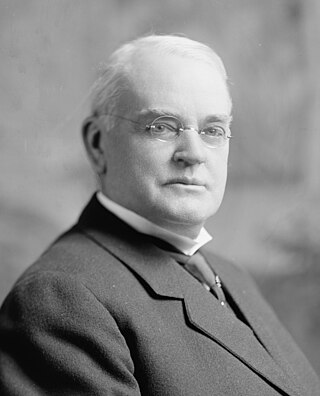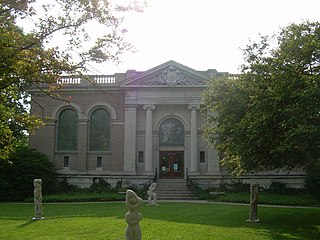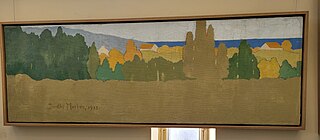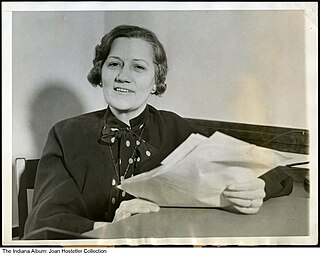
Madge Augustine Oberholtzer was an American woman whose rape and murder played a critical role in the demise of the second incarnation of the Ku Klux Klan. In March 1925, while working for the state of Indiana on an adult literacy campaign, Oberholtzer was abducted by D. C. Stephenson, Grand Dragon of the Indiana Klan. Holding her captive in his private train car, Stephenson raped and tortured her. Oberholtzer died from a combination of a staphylococcal infection from her injuries and kidney failure from mercury chloride poisoning, which she took while held captive in an attempt to commit suicide.

John Downey Works was an American politician and lawyer. He was a U.S. Senator representing California from 1911 to 1917, and an associate justice of the California Supreme Court from October 2, 1888, to January 5, 1891.

The Indiana State Museum is a museum located in downtown Indianapolis, Indiana, United States. The museum houses exhibits on the science, art, culture, and history of Indiana from prehistoric times to the present day.

The neighborhood of Irvington, named after Washington Irving, includes Irvington Historic District, a historic district in Indianapolis, Indiana. The historic district is a 545-acre (221 ha) area that was listed on the National Register of Historic Places in 1987. That year, the district included 2,373 contributing buildings, 5 other contributing structures, and 2 contributing sites.
Diane Meyer Simon is an environmental and political activist, and the founder and leader of Global Green USA and a member of the Green Cross International's (GCI) Honorary Board. She is the former wife of Indiana real-estate billionaire Herbert Simon.

Dorothy Morlan was an American Impressionist artist who was born in Salem, Ohio and lived in Indianapolis, Indiana.

Grace Julian Clarke was a clubwoman, women's suffrage activist, newspaper journalist, and author from Indiana. As the daughter of George Washington Julian and the granddaughter of Joshua Reed Giddings, both of whom were abolitionists and members of the U.S. Congress, Clarke's family exposed her to social reform issues at an early age. She is credited with reviving the women's suffrage movement in Indiana, where she was especially active in the national campaign for women's suffrage in the early twentieth century. She is best known for founding and leading the Indiana State Federation of Women's Clubs, the Legislative Council, and the Women's Franchise League of Indiana. Clarke was the author of three books related to her father's life, and was a columnist for the Indianapolis Star from 1911 to 1929.
Jean Starr was an American actress, dancer, and trumpeter who became a Chicago society figure after marrying Chicago numbers racket tycoon and Jones brothers, McKissack "Mack" McHenry Jones, and becoming Jean Starr Jones.
Leah Schneider Traugott, also known as Leah S. Traugott, was an American award-winning watercolorist and educator. She exhibited in more than eighty one-person shows and numerous group exhibitions.

Wilma Gibbs Moore was a librarian and archivist from Indianapolis, Indiana. She is known for her role as an archivist at the Indiana Historical Society where she spent 30 years dedicated to preserving and interpreting African American history in Indiana by developing the African American History Program and collections. From 1986 to 2007, Moore served as editor to Black History News and Notes which was a free quarterly publication produced by the Indiana Historical Society that shared history and news about African Americans in Indiana.

Louise Terry Batties was an American clubwoman based in Indianapolis, Indiana.

Caroline Henderson Griffiths was an American diplomat's wife and philanthropist. After World War I, she organized book and equipment donations for children's libraries in Belgium and France.
Forrest W. Littlejohn was a lawyer, prosecutor, judge, and state legislator in Indiana. He was elected in parliament 1949 to represent Marion County, Indiana in the Indiana House of Representatives.

Grace Urbahns became the 33rd Treasurer of State in Indiana from January 1926 to February 1931. This made her the first woman to serve in a state-level executive office in Indiana. Among all the states, she was the only woman serving as Treasurer of State. Grace was active in the Republican Party and served as National Committeewoman from Indiana.
Crispus Attucks Museum is a museum inside Crispus Attucks High School located in Indianapolis, Indiana. The museum is operated by the Indianapolis Public School (IPS) system and features exhibitions on local, state, national, and international African American history.

The Kile Oak Tree is a bur oak tree that is a landmark in the historic district of Irvington in Indianapolis, Indiana. The Kile Oak Tree is preserved by the Irvington Historical Society and Irvington Historical Landmarks Foundation. The Kile Oak Tree is assumed to be "somewhere between 300 and 500 years old" and is one of the oldest trees in the city of Indianapolis.
Carrie Whalon (1870-1927) was an African-American and Hoosier suffrage leader and the first President of the First Colored Women's Franchise League/First Colored Woman's Suffrage Club in Indianapolis. Her last name was also spelled as Whallon and Whalen in newspaper articles.

Anna Francis Weaver was an American educator who taught students in several educational institutions in Indianapolis, Indiana in the early 1900s.
Erroll Grandy was an American jazz pianist.












